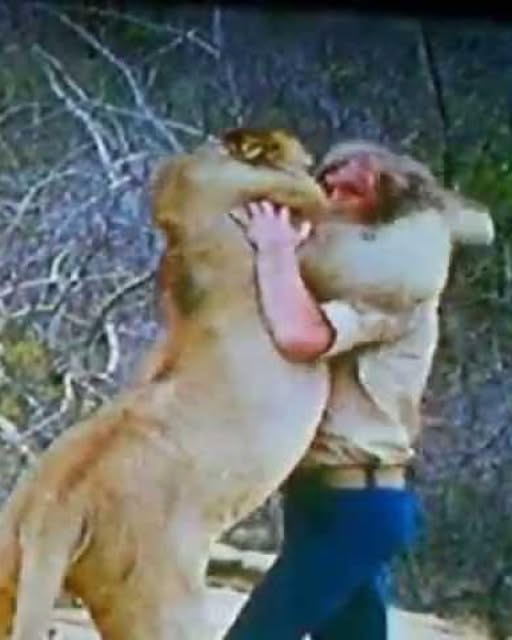In 1969, in London, something wild and magical happened: two young Australians, John Rendall and Anthony “Ace” Bourke, walked into Harrods department store and found—of all things—a lion cub for sale.
They were horrified at the idea of such an animal locked away in a shop, but they also felt called to act. They pooled their resources and bought that cub.
They named him Christian.
From that moment, Christian became more companion than creature kept in a cage. He lived with John and Ace in their Chelsea flat and garden, slept on rugs, followed them around like a pet, and learned to trust human touch and affection.
But Christian was also growing fast—too fast to remain as a “pet” in London. The men realized that their love, though deep, couldn’t replace the wildness etched into Christian’s nature.
So they made one of the toughest decisions of their lives: to send Christian to Kenya and try to reintroduce him to the wild, where he belonged. They enlisted the help of wildlife conservationist George Adamson (who himself was well known for rehabilitating lions).
Under Adamson’s guidance, Christian moved to Kora National Park in Kenya, where he could adapt to natural conditions—learning to hunt, survive, socialize with other lions.
As time passed, Christian became fully wild. He joined and led his own pride. But in the hearts of John and Ace remained a question: Would Christian still remember them?
In 1971, after about a year, John and Ace made the journey to Kenya. They were warned that Christian might not recognize them—after all, he had a new life, new identity.
Yet the moment of reunion became iconic. As they waited, Christian emerged in the distance. He paused, then bounded forward. He leapt, embraced them, rubbed his head against theirs, and licked their faces. There were no signs of fear or aggression — only joy.
storyworks3.scholastic.com
What struck many observers was that Christian even brought forward two lionesses from his pride, introducing them to John and Ace—as if saying, “These are my people.”
It was a profoundly emotional moment, captured by a cameraman, and later rediscovered and shared widely online.
That reunion reminded the world: wildlife is not impersonal, and the bonds we form with animals are real.
The Shadow of Trophy Hunting: Cecil and Walter Palmer
While Christian’s story speaks of connection, love, and respect, there is a darker side to human-wildlife interactions—and that is trophy hunting. In 2015, Cecil the Lion, a famed lion in Zimbabwe’s Hwange National Park, was killed by an American dentist, Walter Palmer, during a hunt.
Cecil was beloved in his homeland, part of a research project and monitored by scientists. His killing sparked a global wave of outrage, media attention, protests, and debate on the ethics of killing wild animals for sport.
Palmer claimed ignorance of Cecil’s identity and argued that the hunt was legal, but public outcry was fierce. Many people saw Cecil’s death not just as the killing of one lion, but as the loss of a symbol.
The case sparked discussions about trophy hunting laws, conservation, government accountability, and how we value wildlife.
One analysis showed that Cecil’s death served as a “focal event” — a moment that concentrated global attention on the plight of lions and wildlife governance, even if policy change proved limited over the long run.
Cambridge University Press & Assessment
Today, it is often cited as an example of ethical failure in how we treat majestic creatures.
Lessons We Must Learn: From Christian to Cecil
Christian’s story and Cecil’s tragedy stand in stark contrast—but together they teach us several urgent lessons.
1. Wild animals are not trophies.
They are sentient beings with feelings, relationships, needs, and dignity. The joy Christian showed in reuniting with his caretakers reveals an emotional life we often ignore.
2. Love is not always enough—but respect must be.
John and Ace cared deeply for Christian, but they also recognized that their love was not sufficient to let him live a full life in the wilderness. Letting go was the humane choice. Respecting animals sometimes means stepping back.
3. Rewilding is possible—with wise support.
Christian’s successful transition to wild life shows that with careful planning, patience, and expert help (like George Adamson’s), rehabilitating animals is possible. But it’s also a difficult, delicate process, and not all animals survive it.
4. Public attention can be powerful.
The outrage over Cecil’s killing brought many people to face the cruelty of trophy hunting. Although one lion’s death cannot undo centuries of exploitation, stories like Christian’s and Cecil’s push us to rethink how humans relate to nature.
5. Conservation ultimately needs commitment, not just sentiment.
Admiration for lions must translate into action—strong protections, anti-poaching measures, habitat conservation, community engagement. The world lion population has declined dramatically.
Final Thoughts
We live in a world where some still see lions as trophies to be won, captured, or killed. But the true power of lions—and our relationship with them—lies in connection. Christian the Lion’s journey shows that even across species, love, memory, recognition can cross boundaries we barely understand.
His story is a challenge: will we treat wild animals as symbols of conquest, or as beings worthy of respect, empathy, and protection?
